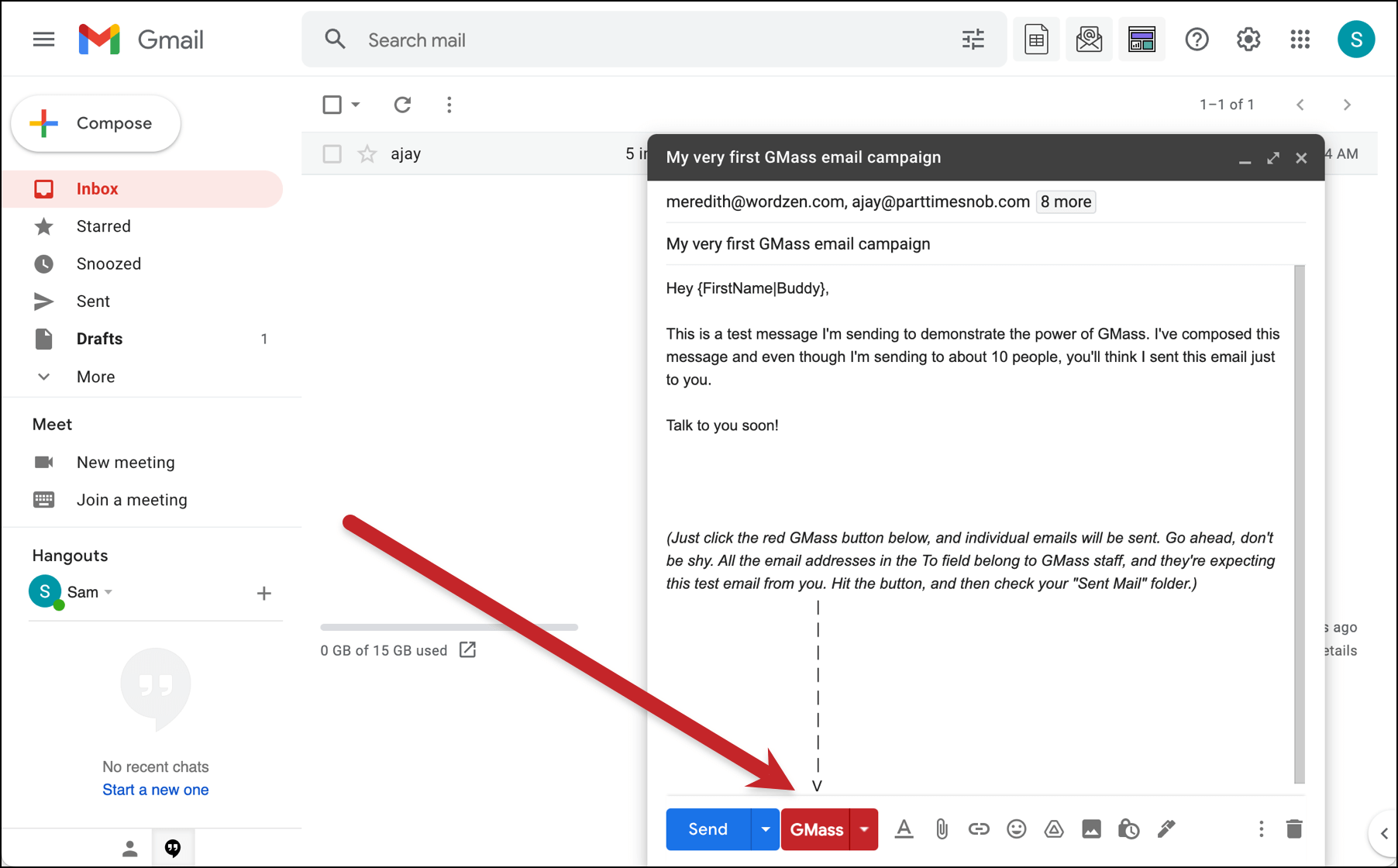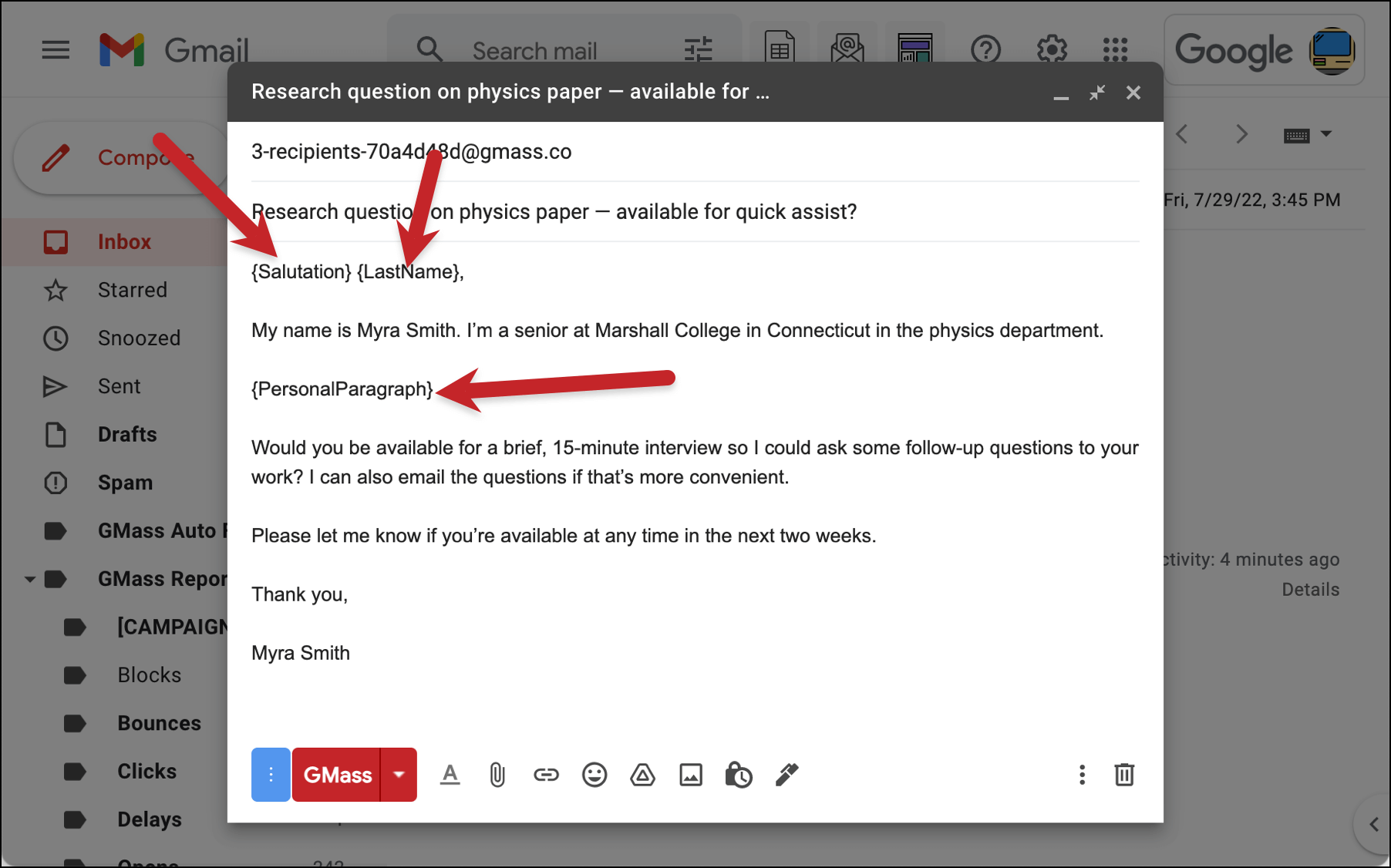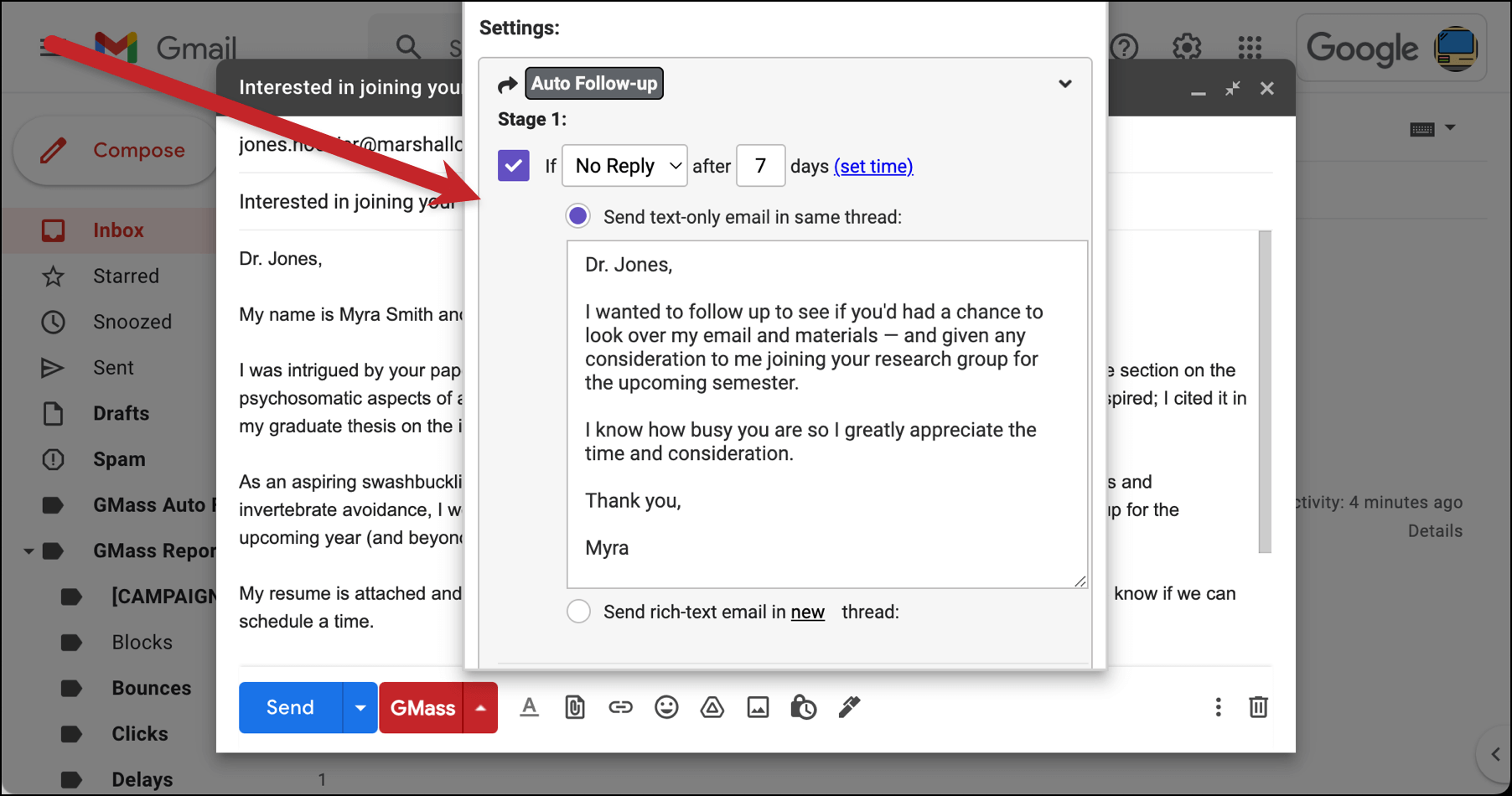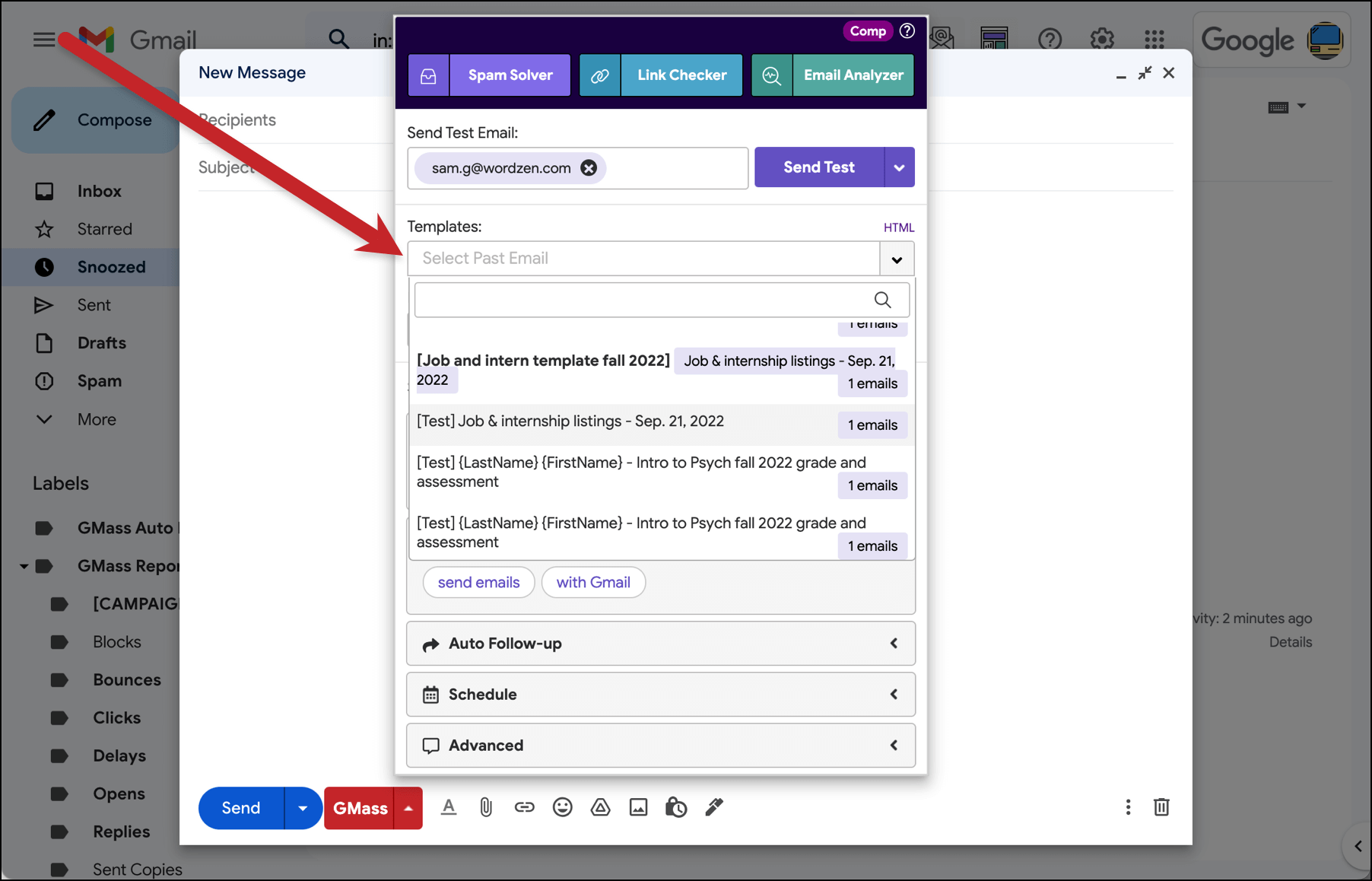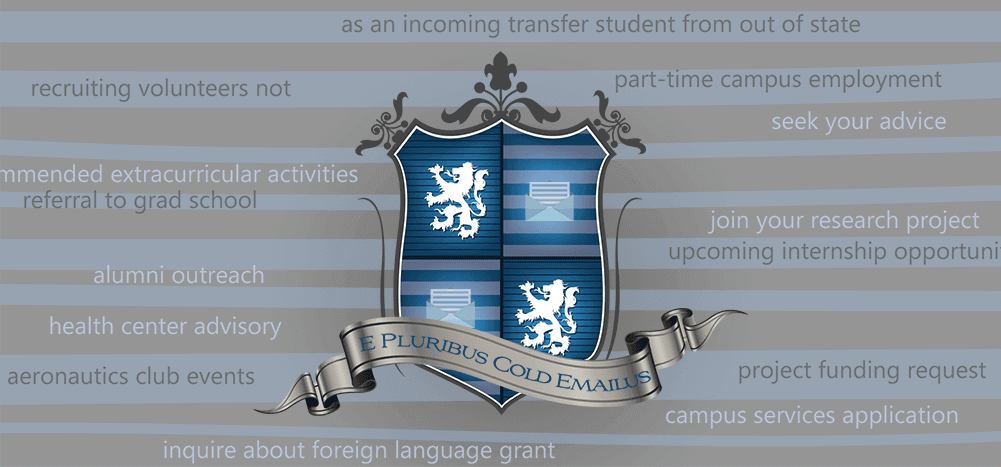
Cold email isn’t just a part of the business world anymore — cold email has packed up its acoustic guitar and Pulp Fiction poster and headed off to college.
Over the past few years there’s been a significant rise in cold email’s popularity in the academic world. From students to professors, administrators to department offices, alumni organizations to clubs, cold email is now a widely-used tool across the entire college and university gamut.
Here at GMass we’ve studied the trends, pored over Twitter, and spoken with more than a dozen people in academia to learn how they’re using cold email to accomplish their (wide variety of) goals faster and more efficiently.
Here’s how the academic world is using cold outreach today.
Cold Email in Academia: Table of Contents
- How College and University Students Are Using Cold Email
- How Clubs and Organizations Are Using Cold Email
- How College Administrators Are Using Cold Email
- How College Academic Departments Are Using Cold Email
- How College Professors, Researchers, and Faculty Are Using Cold Email
- Why GMass Is an Excellent Tool for Cold Outreach in the Academic World
How College and University Students Are Using Cold Email
Perhaps no college cohort uses cold email more than students. Here are some of the most common ways students, from freshmen through Ph.D.s, are using cold outreach.
Want an even more in-depth look at cold emailing for college and university students, including cold email templates? Check out our guide on how to email a professor.
Joining research groups and labs
There’s a question we see a lot on social media: How do I contact a professor about joining their group/lab? And the first answer they always receive is cold email. A well-crafted cold email (as we’ll discuss in the best practices section) can help you get your foot in the door and, ultimately, have a real shot at landing a coveted research group or lab spot.
Best practices
Know specifics about the lab group’s interests before you reach out. You need to make it clear you fully understand what the group is doing and why you’d be a valuable contributor.
Even if you don’t have practical experience, a mix of deep academic curiosity and other traits like perseverance and dedication can close the gap.
Chelsea Dunmire, a research scientist at the University of Washington’s School of Medicine, says most labs wouldn’t expect prior experience from younger students. So she looks for cold emails where students show experience in other areas, “that shows you’re reliable, you can make a long-term commitment, and you’re eager to learn new things.”
Keep it short. Dr. Monica Malta, a professor in the psychiatry department at the University of Toronto, receives lots of cold emails and, “short emails are more likely to be read than longer ones, especially if it comes from someone we don’t know.”
Still, even though you’re keeping it short, don’t neglect the fundamentals of outreach. “Finish with something nice,” Dr. Malta says, “Like, ’Thank you so much for your time.’ … And, if it’s appropriate, mention that you understand their schedule is busy, assuring that they can reply when they have time.”
Advice and mentorship
Undergraduate, graduate, and Ph.D. students face lots of significant (and quite possibly life-altering) decisions throughout their time in school. There are lots of great minds out there at their school and other schools who can offer sagacious, actionable advice — but getting in touch with those people and building a rapport can be challenging.
Cold email has become a go-to method for students reaching out to educators, grad students, and alumni to develop a relationship and receive mentorship throughout their time in school.
All of that is also true for students looking for thesis and Ph.D. advisors. A personalized cold email to a professor can cut through quite a bit of the advisor-finding slog.
Best practices
Make sure the email is highly personalized (and mentioning a quick fact off the professor’s website bio isn’t enough). Dig into the person’s work, read what they’ve published, and cite that.
Dr. Malta has worked with great people who reached out cold. “You need to do your research,” she says, “Don’t start like, ‘Dear Professor,’ it gives the impression you’re sending the exact same email to lots of professors. [The best cold applicants] knew what I was working on… by following me on Twitter where I’m quite active.”
Muneer Yaqub, a Ph.D. candidate in molecular and cell biology at the University of Texas at Dallas (who regularly tweets and makes videos about cold email for students), also highly recommends citing a professor’s work in an outreach message. “Academics get excited a lot about people citing their publications,” he says, “I find this the most effective way to get their attention while cold emailing them for graduate mentorship.”
Try the vision/framing/weakness/pedestal/ask email structure (also known as Very Few Wizards Properly Ask, because mnemonics have taken a bizarre turn in modern times). In a V/F/W/P/A email, you’re using five paragraphs of 1-2 sentences:
- Vision: Who you are and what you’re hoping to accomplish.
- Framing: What stage you’re at.
- Weakness: Where you’re currently falling short.
- Pedestal: Show the person you’re reaching out to how they are the only one who can help thanks to their expertise.
- Ask: Make your request.
Job and internship hunting
There are tons of companies recruiting on college campuses — but some students instead opt for the more proactive approach. We’ve seen lots of students cold emailing companies about potential roles. And with the right approach, those students can stand out more than their peers to land the internships and jobs they’re after.
Best practices
Research the company and be specific why you want to work there. A generic cold email for a job or internship will, at best, get a generic cold response: A link to an online application.
But an email from someone passionate about working at a company — someone who demonstrates a deep understanding of the company and how they’d be a good fit — can earn special attention and consideration.
Play up your college connection (without making that the focus of the entire email). It’s always good to reach out to alumni at a company — even if they aren’t the one doing the hiring, they will often help steer you toward the right person thanks to your shared background.
While you don’t want to make the entire email about your college (it needs to also be about you and why you want to work at that company), citing your school is a great way to make the cold email “warmer.”
My favorite thing about UNC is that you can throw in “go heels!” to any cold email and alumni will go out of their way for you. 1) bc they understand the pain you’ve suffered through 2) bc they want to relive their glory days.
— Tú Uyên (Valerie) Nguyễn (@valerieunguyen) April 16, 2022
That being said, if you didn’t go to the same college, you can play that up too.
2. Become deeply knowledgable about your prospect.
Find their hobbies, read their tweets, know which conferences they attend.
A great cold email I got was from a Vandy alumni who wanted to put a bet on a football game against my Gamecocks. He earned a reply.
— Eric Bandholz (@bandholz) June 21, 2022
Letters of recommendation
While a letter of recommendation request isn’t a pure cold email — after all, if you’re emailing a professor for a letter of recommendation, they should know who you are — it is an unanticipated request. Many of the standard cold email practices still apply when you’re reaching out for a recommendation; after all, you’re asking a professor to devote some of their time to you.
Best practices
Refresh their memory. Again, while a letter of recommendation request isn’t a cold email — it’s close. Especially if it’s been a little while since you took the professor’s class.
Make sure to use your email to refresh the professor’s memory about who you are, your relationship, and the most notable thing you accomplished in their class. It’s also great to explain how you’ve applied what you learned since then (and, in particular, how their teaching ties directly into the job or program for which you need their recommendation).
Don’t send a last-minute request. A professor isn’t going to be happy if you send a request for a letter of recommendation that’s due in the next 48 hours. Give the professor a reasonable amount of time (say, a few weeks) to put together the letter. That amount of time also reflects well on you — it shows you’re prepared, organized, and serious.
Scott Shapiro, a law professor and philosophy professor at Yale University, says students shouldn’t be afraid to ask for letters of recommendation — as long as the aren’t last-minute requests, most professors will be happy to write them.
My annual letter of recommendation tweet: Do not feel bad asking professors for letters. 1) It’s our job. We are not doing you a favor. 2) How do you think we got our jobs? We’ve asked for many letters. It’s the Circle of Life. Don’t sweat it, just give your writers enough time.
— Scott Shapiro (@scottjshapiro) March 26, 2022
How Clubs and Organizations Are Using Cold Email
Campus clubs and organizations have also gotten in on the cold email trend at colleges and universities. While some clubs and organizations lean a bit heavier on the social media side, there are key areas where email is the more effective medium. Here’s how clubs and organizations are using cold email.
Recruiting
We haven’t seen that many on-campus clubs and organizations using cold email to recruit new members. Maybe it seems too forward (or too needy)? Social media and in-person recruiting seem more popular.
But we have seen some cases where a single targeted mass email blast can be an effective recruitment tool. (For example, the university newspaper sending an email to all incoming freshmen in the journalism department to let them know about a welcome mixer.)
Best practices
Promote an event with the email. All cold emails need some kind of a call-to-action. For clubs and organizations, the best call-to-action can be an invitation to an event (like a mixer, notable guest speaker, dinner, and so on). The event shows the student a clear benefit and is less committal than a call-to-action asking them whether or not they want to join the club.
Reach out to targeted incoming freshmen. Incoming freshmen will appreciate cold outreach from clubs (more than grizzled, cynical students who are already on campus, naturally). Invite freshmen to your event, explain what your club is and what it does, and even offer to connect the freshmen with older students in the club who can help them when they get to campus.
Outreach to businesses and alumni
Whether a club is looking for sponsors for an event or career opportunities for its members, email outreach is an effective way to cast a wide net and deliver fast results.
Best practices
Use automated follow-ups. Don’t overdo it with follow-ups — but do follow up. The people you’re reaching out to are busy. A second email nudge about a week after your initial email should help you get a higher volume of replies (and sending two emails doesn’t seem excessive or overbearing).
How College Administrators Are Using Cold Email
College administrators have fewer cold email needs than most other groups on campus. However, we have seen a few cases where administrative offices have used cold email in an effective manner.
Want more on the types of emails administrators send and ways to send those emails more efficiently? Check out our complete guide to college administrator emails.
Outreach for donations
Yes, colleges are always on the hunt for donations. (They also have remarkable private investigator skills to track down their alumni. How do they keep figuring out my address changes? How?) Cold outreach to alumni and other notable donors is an ongoing and never-ending process for colleges everywhere.
Best practices
Make it clear what you’re raising money for (and why). Your cold donation email should explain why you’re raising money. Demonstrate what the money is going to — if possible, even with specific examples. Yes, there are lots of alumni who will donate solely out of loyalty or school spirit.
But there are also lots of them who want a more granular understanding about the purpose of their donation.
Make sure you’re not overwhelming people with only donation request emails. An administrative director at a university in New York told me she keeps meticulous records on how often she’s emailing alumni to make sure she’s properly spacing out donation requests. “You never want someone to feel like you’re only keeping in touch with them for money,” she says, “So we make sure we always send newsletters and other emails before we send another donation request.”
(You may even want to consider setting up your email tool to suppress emails to some contacts based on the number of days since your last email.)
Filling advisory boards
Colleges often reach out to alumni, local leaders, politicians, and other prominent figures to serve on prestigious advisory boards. We’ve seen quite a few colleges using cold outreach to begin these conversations.
Best practices
Make the commitment clear. It’s important to keep these emails (like all cold emails) concise. However, you should devote space in your email to describing the nature of the commitment. How much time is required? Is there an in-person element? Once a prospective board member knows the commitment they can make a better judgment on whether they’re interested in joining.
Use social proof. I spoke with an outreach specialist who works with colleges on external recruiting for boards and committees. She says she found better results in her emails when she shares a brief list of the notable companies where current board members work.
If prospective board members know other people at their career level are on the board, it motivates them to reply to the cold email to get involved as well.
How College Academic Departments Are Using Cold Email
Departments always need students for various groups and programs (as we’ll cover below) — and it can be a challenge to get the right messaging in front of those students. Here’s how college departments are using cold email to streamline the student recruitment process.
Check out our article for even more on how college departments and faculty can use personalized mass emails.
Recruiting study participants
Psychology departments (among many others) need a regular flow of students for studies. Cold email is an efficient means for reaching out to the right students to inform them about studies.
Best practices
Emphasize what’s in it for them. As great as it would be if an endless stream of undergrads participated in your studies solely because they cared about advancing human knowledge… most need an incentive beyond that.
Make sure your cold email emphasizes what they’ll get out of it. Some undergrad classes require students participate in a certain number of studies as a requirement — how many credits will they get for this study? Will you be paying participants? Are you offering free pizza? Is it a networking opportunity? Emphasize the benefit for the students in participating.
Do you love free pizza? Do you have opinions? Of course you do!
Stop by WMU Parkview Campus this weekend and help a local PhD student with her thesis research.
Requires only 10 minutes of a walking simulation and a short survey afterward. Free pizza for participants! pic.twitter.com/Sz1nxTMBQG
— ModeShift Kalamazoo (@ModeShiftKzoo) March 17, 2022
Share the details in list form, not paragraph form. Make sure your email is easily skimmable. That allows prospects to better comprehend the details at a glance — and can lead to better response rates. Rather than a paragraph saying something like, “The study is Sunday, March 20th from noon to 3:00 P.M. in room F-212 at the College of Engineering and Applied Sciences” — lay out the details as a bulleted list.
- When: Sunday, March 20th
- Time: Noon to 3:00 P.M.
- Where: College of Engineering and Applied Sciences, room F-212
Recruiting students from within the department (tutors, mentors, study group participants)
Department offices regularly need to recruit students from within the department for various roles. We’ve seen departments at colleges all over the world using cold outreach to recruit a deep bench of tutors, mentors, and guides. Focus groups are another area where college departments need students. Cold email can be far more effective than, say, a flier posted outside of some classrooms.
Best practices
Target your list (so you don’t train students your emails are irrelevant). If you’re looking to recruit juniors and seniors to mentor students, don’t send to freshmen and sophomores as well. If you’re looking for focus group participants to discuss your department’s career services center, reach out to students who’ve used the career services center.
If you send recruiting emails that are irrelevant, you train students to ignore your emails. So filter your list to make sure the students in your department prioritize and open your future messages.
How College Professors, Researchers, and Faculty Are Using Cold Email
College professors and faculty receive quite a bit of cold email (as demonstrated earlier in the section about cold emails students send). However, faculty can also glean benefits from sending cold emails themselves.
Outreach to journals
Professors, researchers, and other university faculty can use cold email to speed up the process of getting their papers published.
Best practices
Don’t be afraid to email early in the research process. Dr. Malta says cold email to journals and other editors can be a major time saver. She sends cold emails to editors “inquiring if my paper might be of interest — and, quite frankly, this strategy has helped me to avoid months of waiting for peer review just to have a paper denied.”
Consider networking before jumping right into talking about publication. “If, by any chances, you met this person at a cocktail party, how would you approach them?” Dr. Malta says, “You probably wouldn’t just walk up and start pitching them, right? Some stuff gotta come first, like you need to introduce yourself and hopefully say something nice. Then you might try to connect with this person, either by mentioning a shared friend or interest, and later you could make your pitch.”
Networking emails
University faculty members are using cold email to network with faculty in similar (or complementary) areas at other schools, as well as everyone from conference organizers to grant organizers.
Best practices
Cast a wide net — you never know what might happen. “I am currently on the job market looking for research positions in biotech,” Dunmire says, “I’ve been able to talk with scientists who are currently in roles I hope to be in one day, and I can’t emphasize enough how insightful these conversations have been. I’ve gotten my resume reviewed multiple times, had job postings forwarded to me, and have received really good advice on my transition from academia to industry. It all started with deciding to cold email… these people and asking to chat.”
Why GMass Is an Excellent Tool for Cold Outreach in the Academic World
Thousands of people in academia are using GMass to help send cold emails. We’ve built GMass as a diverse tool that works for a variety of purposes — whether you need to send a personalized mass email to everyone in your department using mail merge… or whether you need to send a single cold email to a professor and want tracking, scheduling, and automated follow-ups.
Here’s a handful of GMass features that resonate particularly well with our users in the academic world.
Works inside Gmail
GMass doesn’t require you to use new email software or send through someone else’s servers. GMass works right inside Gmail and Google Workspace, bringing cold email right into your normal email flow.
Connects with Google Sheets
Connect your Google Sheet to a GMass campaign. You can use the columns in your spreadsheet as mail merge features and personalize everything, from names to entire paragraphs to attachments.
Automated follow-ups
You can send up to eight automated follow-ups to a message with GMass. And you can choose what trigger will stop the sequence to a contact (for instance, the follow-ups stop once they reply).
Open, click, and reply tracking
With GMass you’ll know when recipients open your email. In addition you can see when they click and when they reply. You can even easily create future email campaigns based around those responses (for instance, sending a follow-up campaign to everyone who opened your email but never replied).
Templates
GMass turns every campaign you send into a template you can reuse in the future. So once you write the perfect cold email, you can re-use it in the future as a one-click template.
Polls
Send simple, one-question email polls with GMass. And you can view the results right in your Google Sheet of recipients.
Automatic discount for .edu accounts
I saved this one for last: Any accounts with a .edu domain automatically get a 15% discount off GMass’s published prices.
Get started with GMass and send your first cold email in a matter of minutes
To get started with GMass, head to the Chrome Web Store and download the GMass extension. (You also may want to read our 7,500+ glowing reviews while you’re there. Look at me, giving people in the academic world some homework. It took me decades but I’ve finally turned the tables.)
You can check out our quickstart guide to get rolling — and try out GMass for free to send up to 50 emails per day during your free trial. Join the thousands of others in the academic world using GMass to send better cold emails that get the results you’re after.
GMass is the only tool for marketing emails, cold emails, and mail merge — all inside Gmail. Tons of power but easy to learn and use.
TRY GMASS FOR FREE
Download Chrome extension - 30 second install!
No credit card required

